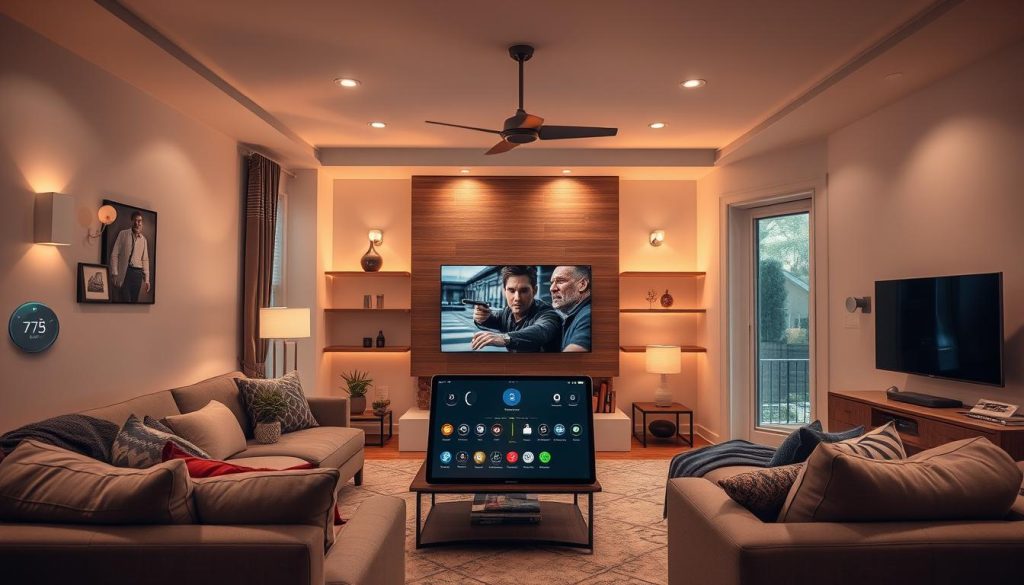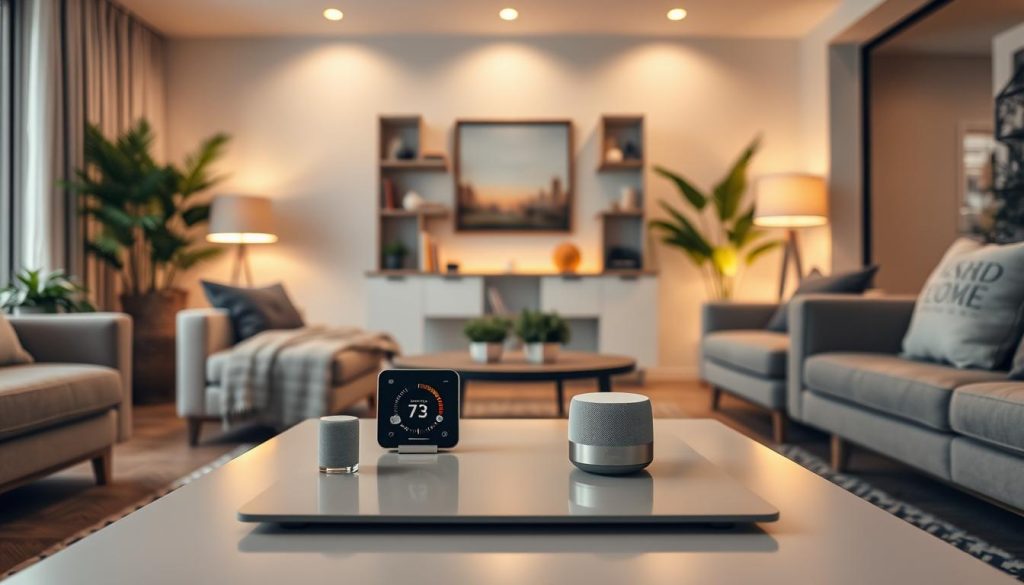Welcome to my beginner’s guide to home automation. Here, I’ll show you how to turn your home into a smart one. You’ll learn everything you need to know to get started.
I’ll give you a step-by-step guide to start your home automation journey. It’s designed to be easy, so you can dive into the world of home automation without stress.
We’ll cover the basics and help you pick the right devices and platforms. By the end, you’ll know how to start your home automation journey easily.
Understanding Home Automation Basics
To start with home automation, you need to know the basics. This means understanding smart home tech and how it helps set up an easy system. You’ll be able to control and watch over your home’s lighting, temperature, and security easily.
Knowing about smart home tech is key for a smooth home automation experience. With the right info, you can create a system that fits your needs perfectly. This makes your life easier and more fun.
What is Home Automation?
Home automation uses tech to manage your home. This includes lights, temperature, security, and entertainment systems. By automating these, you make your home more comfy and convenient.
Benefits of Home Automation
Home automation offers many benefits. It makes life easier, saves energy, and boosts security. With a simple setup, you can control your home from anywhere using your phone or tablet.
Common Home Automation Technologies
Common techs in home automation are Wi-Fi, Bluetooth, and Zigbee. These let devices talk to each other for a smooth experience. Knowing these techs helps you set up a system that suits you.
| Technology | Description |
|---|---|
| Wi-Fi | A wireless networking tech that lets devices connect to the internet |
| Bluetooth | A wireless tech for personal area networks that lets devices talk to each other |
| Zigbee | A low-power tech for wireless communication that lets devices talk to each other |
Assessing My Needs and Goals
To start with home automation, I need to figure out what I want. I should think about which parts of my home I want to automate. This could be lighting, security, or entertainment systems. Knowing my lifestyle and preferences helps me choose the right smart devices and platforms.
Setting a budget is also key for beginners. I need to decide how much I’m willing to spend. This helps me pick the best options. I should think about the cost of devices, platform fees, and any extra services or features I might want.

Identifying Key Areas for Automation
- Lighting: smart bulbs and switches
- Security: smart locks and cameras
- Entertainment: smart speakers and streaming devices
Setting a Budget for My Home Automation
With my needs and budget in mind, I can plan my home automation. This ensures I get the most from my devices and platforms. Following the right tips and steps, I can enjoy the benefits of home automation.
| Device/Platform | Cost | Features |
|---|---|---|
| Smart Bulbs | $20-$50 | Energy efficiency, scheduling, color changing |
| Smart Locks | $100-$300 | Keyless entry, biometric authentication, remote monitoring |
| Smart Speakers | $50-$200 | Voice control, streaming, smart home integration |
Choosing the Right Home Automation Platform
Choosing the right home automation platform can be tough. It’s important to look at popular options and key factors. These include compatibility, ease of use, and how well it can grow with your needs.
Platforms like Samsung SmartThings, Apple HomeKit, and Amazon Alexa are popular. Each has its own strengths and weaknesses. Think about what you need and what you want to achieve with your smart home.
Overview of Popular Platforms
- Samsung SmartThings: Offers a wide range of compatible devices and intuitive voice control
- Apple HomeKit: Provides a secure and seamless smart home experience with Siri integration
- Amazon Alexa: Supports a vast array of devices and offers advanced voice control capabilities
Factors to Consider When Selecting a Platform
When picking a platform, think about compatibility, ease of use, and growth potential. Also, check the platform’s security and customer support. By weighing these factors, you can choose the best platform for your smart home.

Selecting Smart Devices for My Home
Starting my smart home journey means picking the right devices. This is key to making my life easier and more efficient. It’s important to know about the different smart devices out there.
I need to think about what my home and family need. Smart thermostats can control the temperature, and security cameras add safety. Smart lights make everything automated. I should check if they work with my current systems.
Some top smart devices to look at are:
- Smart thermostats from brands like Nest or Ecobee
- Security cameras from companies like Ring or Arlo
- Smart lighting systems from brands like Philips Hue or LIFX

Choosing the right devices and following the installation steps is crucial. This way, I can make my home smarter and more connected. It will improve my life and work well with what I already have.
| Smart Device | Brand | Compatibility |
|---|---|---|
| Smart Thermostat | Nest | Wi-Fi, Bluetooth |
| Security Camera | Ring | Wi-Fi, Battery-Powered |
| Smart Lighting | Philips Hue | Wi-Fi, Zigbee |
Setting Up My Smart Home Network
To enjoy a seamless home automation experience, setting up a reliable smart home network is crucial. This involves understanding the importance of a stable internet connection and choosing the right devices. A reliable Wi-Fi connection is the backbone of any smart home system, enabling devices to communicate with each other and with the internet.
When it comes to understanding smart home technology, it’s essential to consider the role of smart hubs and standalone devices. Smart hubs act as the central control point for my smart home devices, while standalone devices can operate independently. To make an informed decision, I need to weigh the pros and cons of each option and consider my specific needs and goals.
Importance of a Reliable Wi-Fi Connection
A reliable Wi-Fi connection is vital for a smooth home automation experience. It enables me to control my devices remotely, receive updates, and access various features. A stable internet connection also ensures that my devices can communicate with each other seamlessly.
Utilizing Smart Hubs vs. Standalone Devices
Smart hubs and standalone devices have their own advantages and disadvantages. Smart hubs offer a centralized control point, making it easier to manage my devices. However, they can be more expensive and may require additional setup. Standalone devices, on the other hand, are often more affordable and easier to install but may not offer the same level of integration.
Here are some key considerations for choosing between smart hubs and standalone devices:
- Scalability: Can the device or hub support multiple devices and integrate with other smart home systems?
- Compatibility: Is the device or hub compatible with my existing devices and systems?
- Ease of use: How easy is it to set up and use the device or hub?

By considering these factors and understanding the importance of a reliable Wi-Fi connection, I can create an easy home automation setup that meets my needs and provides a seamless smart home experience.
Integrating Voice Assistants
I’m excited to explore how voice assistants can make my home smarter. Voice assistants like Amazon Alexa, Google Assistant, and Apple Siri let me control devices easily. I’ll share tips on setting them up and using voice commands.
Popular Voice Assistants to Explore
Some top voice assistants are:
- Amazon Alexa
- Google Assistant
- Apple Siri
These assistants work with many smart home devices. I can control lights, thermostats, and cameras just by talking. Smart home tips help me make my home more automated.
Setting Up and Using Voice Commands
To start, I set up the voice assistant and link it to my smart home. Then, I use voice commands to control devices. For example, “Turn on the living room lights” or “Adjust the thermostat to 72 degrees.”
With time, I learn more commands and create custom routines. This makes my home automation better.
Creating Automation Routines
To get the most out of my home automation system, I need to create automation routines that fit my daily life. This is where the best devices for home automation come into play. They allow me to customize my setup to suit my needs. As a beginner’s guide to smart home systems, it’s essential to understand how to create these routines.
One of the most significant advantages of home automation is the ability to automate repetitive tasks. For example, I can set up a routine to turn on the lights when I enter a room or adjust the thermostat when I leave the house. These routines can be customized using various devices and platforms. This makes it easy to find the best devices for home automation that suit my needs.
Some examples of daily automation routines include:
- Turning on the coffee maker when I wake up
- Locking the doors and turning off the lights when I leave the house
- Adjusting the thermostat to a comfortable temperature when I’m home
By following a beginner’s guide to smart home systems, I can learn how to create these routines. I can customize my automation settings to fit my specific needs. This will help me get the most out of my home automation system. It makes my life easier and more convenient.
| Device | Function |
|---|---|
| Smart Light Bulb | Turns on and off automatically |
| Thermostat | Adjusts temperature automatically |
| Security Camera | Records footage automatically |
Security in Home Automation
Exploring home automation, I’ve learned security is key. With more smart devices, protecting them and our network is crucial. Cybersecurity is essential to stop unauthorized access and data breaches.
To keep my smart home safe, I’ve taken several steps. I’ve set up password protection, update software regularly, and segmented my network. These actions lower the risk of my devices being hacked. For example, using strong passwords and keeping software updated can block hacking attempts.
Here are some tips for securing smart devices:
- Use two-factor authentication whenever possible
- Limit access to my network by using guest networks for visitors
- Regularly monitor my network for suspicious activity
By following these tips and steps, I can enjoy home automation safely. Security is an ongoing task. It’s important to stay updated and adapt to new threats.
| Security Measure | Description |
|---|---|
| Password Protection | Using strong and unique passwords for each device |
| Software Updates | Regularly updating software to ensure latest security patches |
| Network Segmentation | Limiting access to my network by using guest networks for visitors |
Troubleshooting Common Issues
Enjoying my easy home automation setup has taught me the importance of smart home tech. Even with a great setup, problems can still happen. It’s vital to know how to fix them.
Common issues include connectivity problems, device malfunctions, and software glitches. These can be annoying, but they’re fixable. Regular upkeep and updates help avoid these issues and keep my devices working well.
Identifying Common Problems
Some common issues I’ve faced are:
- Device connectivity problems
- Software updates failing to install
- Smart devices not responding to voice commands
Effective Solutions for Technical Difficulties
To solve these problems, I take a few steps. First, I check my device connections to make sure they’re secure. Then, I restart my devices and look for any software updates. If the issue continues, I refer to the user manual or reach out to the manufacturer’s support.
By following these steps and keeping up with smart home tech, I have a smooth home automation experience. With an easy setup and knowledge of smart home tech, I can quickly solve any problems. This ensures my devices work efficiently and without hassle.
Expanding My Home Automation System
The world of home automation is always changing. It’s key to keep your smart home up-to-date with the latest tech. This way, your system stays efficient and adaptable for years.
Thinking about new trends like AI and IoT is important. These technologies bring more convenience and efficiency to your home. Look for the best devices for home automation and learn how to add them smoothly to your system.
Also, always check out new tech in home automation. You might find cool things like voice assistants or smart appliances. These can make your beginner’s guide to smart home systems even better.


